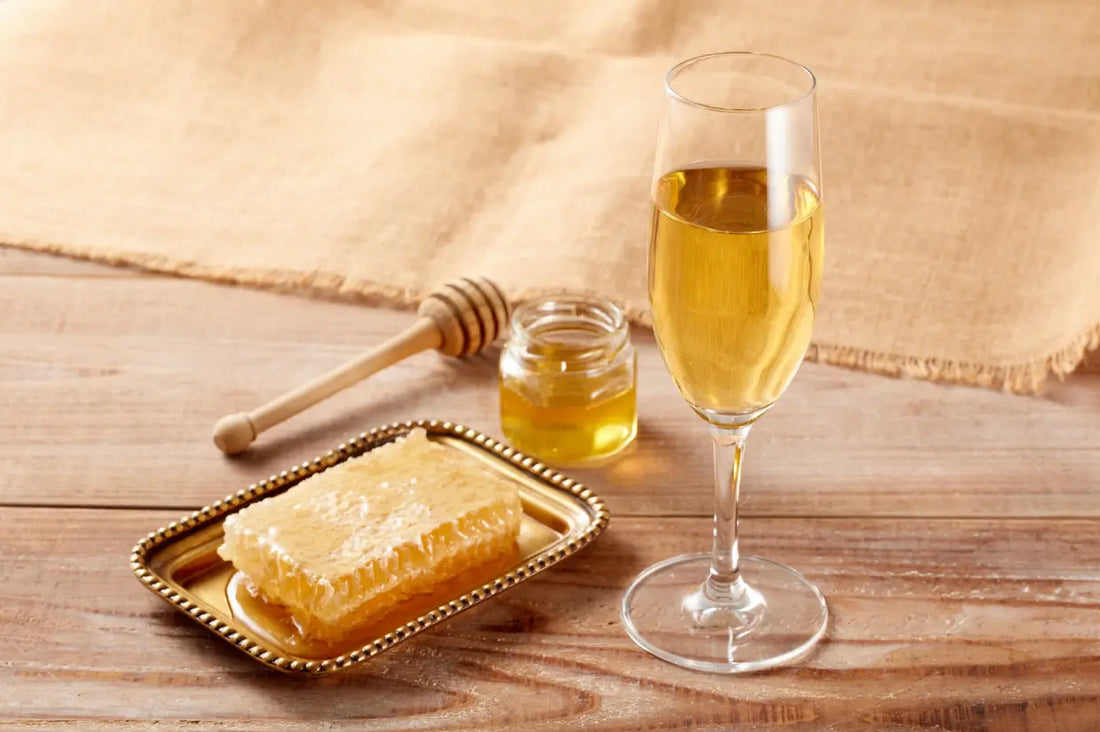
10 Best Sweet White Wines To Try: Types, Tasting Notes & Perfect Pairings
Sweet white wine is perfect for both newcomers and seasoned connoisseurs with its lively aromas, rich flavours, and delightful versatility. Whether you’re relaxing after dinner or searching for the perfect pairing, a glass of sweet white wine can add a special touch of joy. In this guide, we'll explore what makes sweet white wine so special, showcase some of the top grape varieties, introduce key types, and share friendly tips on tasting and food pairings.
What is Sweet White Wine?
Sweet white wines are known for their lovely, natural sweetness, thanks to their higher residual sugar. Unlike dry whites, where most of the grape sugars turn into alcohol during fermentation, sweet whites keep some of that delicious natural sugar, giving them a range from gently off-dry to rich and syrupy.
These wines delight with their vibrant fruit and floral aromas, lively acidity, and a broad spectrum of flavours, from tropical fruits and honey to warming spices. Thanks to skilful winemaking and careful grape selection, sweetness in white wines doesn’t mean they’re boring or simple. In fact, many of the world's most celebrated and age-worthy wines are beautifully sweet whites.
How is Sweet White Wine Made?
The secret to the sweetness of white wine comes from the careful winemaking methods that keep the natural sugars in the grapes intact.
- Arrested Fermentation: Winemakers stop fermentation before all sugar is converted to alcohol, leaving residual sweetness.
- Late Harvest: Grapes are left on the vine longer, developing higher sugar concentrations.
- Noble Rot (Botrytis Cinerea): This beneficial fungus dehydrates grapes, concentrating their sugars and flavours.
- Freezing (Ice Wine): Grapes naturally freeze on the vine, intensifying sugar content.
- Fortification: Adding grape spirit during fermentation halts yeast activity, preserving sweetness.
Each method creates a unique style of sweet white wine with its own character and complexity.
Want to serve wine like a pro at your next cheese night? Discover how many glasses you can pour from each bottle with our guide: How Many Glasses of Wine in a Bottle? A Smarter Way to Serve Wine Anytime.
10 Types of Sweet White Wine You Should Try
Sweet white wines are wonderfully varied, each offering its special flavours, lovely aromas, and fascinating story. Here are ten top picks that you'd enjoy exploring.
Sauternes
Sauternes is often seen as the quintessential sweet white wine, celebrated for its rich, indulgent style and impressive ageing ability. Crafted mainly from Sémillon grapes that have been affected by noble rot (Botrytis cinerea), it offers an enjoyable mix of honeyed notes, apricots, and nutty undertones, all perfectly balanced by its lively acidity. Each glass is a true testament to France’s winemaking excellence.
- Style/Structure: Lusciously sweet, full-bodied, often with high acidity
- Flavours: Honey, apricot, marmalade, toasted nuts, candied citrus
- Region: Bordeaux, France
- Food Pairings: Blue cheese, foie gras, fruit tarts, crème brûlée
German Riesling
German Riesling is renowned for its perfect balance of bright acidity and natural sweetness. From the Mosel to Rheingau, late-harvest and botrytised Rieslings, such as Spätlese, Auslese, Beerenauslese, and Trockenbeerenauslese, are truly exceptional, offering a taste experience that moves between zesty citrus, stone fruits, and honey. The best examples are both incredibly refreshing and richly complex.
- Style/Structure: Ranges from medium-sweet to intensely sweet; light to medium body
- Flavours: Green apple, peach, honey, citrus, floral notes
- Region: Germany (Mosel, Rheingau, Pfalz, Nahe)
- Food Pairings: Spicy Asian dishes, apple desserts, roast pork, soft cheeses
Tokaji Aszú
Tokaji Aszú is Hungary’s famous sweet wine, crafted from carefully hand-picked botrytised grapes. Its rich golden colour and honeyed notes are well known, and it has a refreshing quality thanks to its natural acidity. Tokaji Aszú is both indulgent and well-balanced, often called “the wine of kings.”
- Style/Structure: Rich, sweet, beautifully balanced by acidity
- Flavours: Apricot, honey, orange zest, exotic spices, marmalade
- Region: Tokaj, Hungary
- Food Pairings: Blue cheese, roasted nuts, caramelised apple desserts, dark chocolate
Ice Wine
Ice wine, or Eiswein, is a delicacy made from grapes that freeze naturally on the vine. This freezing process concentrates the sugars and flavours, giving us a wonderfully sweet wine without being overly cloying. Canada and Germany are renowned for producing some of the finest ice wines in the world.
- Style/Structure: Intensely sweet, vivid acidity, medium to full body
- Flavours: Peach, apricot, tropical fruit, honey, citrus
- Region: Canada (Ontario), Germany
- Food Pairings: Fruit-based desserts, cheesecake, pâté, fresh berries
Vin Santo
Vin Santo is a traditional Italian dessert wine made from grapes that are dried on straw mats before fermentation. It’s typically a lovely amber colour, with nutty, caramel, and dried fruit flavours. It’s often enjoyed alongside crunchy Tuscan almond biscuits.
- Style/Structure: Medium to very sweet, viscous, smooth finish
- Flavours: Dried fig, honey, almond, caramel, raisin
- Region: Tuscany, Italy
- Food Pairings: Cantucci (almond biscuits), biscotti, fruit tarts, blue cheese
Moscato d'Asti
Moscato d’Asti provides a wonderfully light and gently bubbly experience, perfect for casual sipping or celebrating special moments. This Italian favourite is renowned for its floral aroma, sweet peach notes, and lower alcohol content, making it a crowd-pleaser for any occasion.
- Style/Structure: Light-bodied, slightly sparkling (frizzante), low alcohol
- Flavours: Peach, orange blossom, pear, citrus, honeysuckle
- Region: Piedmont, Italy
- Food Pairings: Fruit salads, light pastries, lemon cake, fresh berries
Gewürztraminer Vendange Tardive / Sélection de Grains Nobles
From Alsace, these late-harvest and botrytised Gewürztraminer wines are celebrated for their vibrant aromatics and rich, spicy sweetness. In every glass, you'll find lush notes of lychee, rose petals, and exotic spices, a true reflection of what makes Gewürztraminer so distinctive.
- Style/Structure: Rich, sweet, aromatic, often opulent texture
- Flavours: Lychee, rose, ginger, exotic spice, honey
- Region: Alsace, France
- Food Pairings: Spiced Asian dishes, ginger desserts, fruit tarts, foie gras
Vouvray Moelleux / Doux
Vouvray Moelleux or Doux wines showcase the sweeter side of Chenin Blanc, offering great versatility and the potential to age beautifully. These Loire Valley wines can be lovely, balanced perfectly with refreshing acidity, and feature flavours ranging from apple and quince to honey and candied citrus.
- Style/Structure: Medium to intensely sweet, lively acidity, age-worthy
- Flavours: Quince, apple, honey, citrus, floral notes
- Region: Loire Valley, France
- Food Pairings: Blue cheese, tarte Tatin, spiced duck, fruit compote
Barsac
Barsac, just next door to Sauternes in Bordeaux, is known for producing elegant, slightly lighter sweet wines. Made using the same noble rot technique, Barsac wines are fragrant and delicate, offering a refreshing lift that makes them particularly graceful.
- Style/Structure: Lusciously sweet, lighter body than Sauternes, fresh acidity
- Flavours: Citrus, honey, apricot, white flowers, almond
- Region: Bordeaux, France (Barsac AOC)
- Food Pairings: Foie gras, lemon tart, panna cotta, goat cheese
Recioto di Soave
This rare Italian treasure from Veneto is produced by drying Garganega grapes to intensify their sugars and flavours. Recioto di Soave is a golden hue, rich in character, yet often overlooked. It offers an elegant balance of sweetness and refinement, making it a delight for those seeking something special.
- Style/Structure: Sweet, full-bodied, lingering finish
- Flavours: Dried apricot, almond, honey, candied orange
- Region: Veneto, Italy
- Food Pairings: Almond cake, panna cotta, ricotta desserts, aged cheese
| 10 Types of Sweet White Wine You Should Try | ||||
|---|---|---|---|---|
| Sweet White Wine | Style/Structure | Flavours | Region | Best Food Pairings |
| Sauternes | Lusciously sweet, full-bodied | Honey, apricot, marmalade, toasted nuts | Bordeaux, France | Blue cheese, foie gras, fruit tarts, crème brûlée |
| German Riesling | Medium to intensely sweet, light to medium body | Green apple, peach, honey, citrus, floral | Germany (Mosel, Rheingau, Pfalz, Nahe) | Spicy Asian dishes, apple desserts, roast pork, soft cheeses |
| Tokaji Aszú | Rich, sweet, balanced by acidity | Apricot, honey, orange zest, exotic spices | Tokaj, Hungary | Blue cheese, roasted nuts, caramelized apple desserts, dark chocolate |
| Ice Wine (Eiswein) | Intensely sweet, vivid acidity, medium to full body | Peach, apricot, tropical fruit, honey, citrus | Canada, Germany | Fruit-based desserts, cheesecake, pâté, fresh berries |
| Vin Santo | Medium to very sweet, viscous, smooth finish | Dried fig, honey, almond, caramel, raisin | Tuscany, Italy | Cantucci (almond biscuits), biscotti, fruit tarts, blue cheese |
| Moscato d’Asti | Light-bodied, slightly sparkling, low alcohol | Peach, orange blossom, pear, citrus, honeysuckle | Piedmont, Italy | Fruit salads, light pastries, lemon cake, fresh berries |
| Gewürztraminer Vendange Tardive / Sélection de Grains Nobles | Rich, sweet, aromatic, opulent texture | Lychee, rose, ginger, exotic spice, honey | Alsace, France | Spiced Asian dishes, ginger desserts, fruit tarts, foie gras |
| Vouvray Moelleux / Doux | Medium to intensely sweet, lively acidity, age-worthy | Quince, apple, honey, citrus, floral notes | Loire Valley, France | Blue cheese, tarte Tatin, spiced duck, fruit compote |
| Barsac | Lusciously sweet, lighter body than Sauternes, fresh acidity | Citrus, honey, apricot, white flowers, almond | Bordeaux, France (Barsac AOC) | Foie gras, lemon tart, panna cotta, goat cheese |
| Recioto di Soave | Sweet, full-bodied, lingering finish | Dried apricot, almond, honey, candied orange | Veneto, Italy | Almond cake, panna cotta, ricotta desserts, aged cheese |
Serving Tips for Sweet White Wine
Serving sweet white wine the right way brings out its best flavours and aromas, making your tasting experience all the more enjoyable. Here are some tips that will help you appreciate each glass to the fullest.
- Serve well-chilled: Ideal temperature is 8-10°C (46-50°F) to highlight freshness and balance sweetness.
- Choose the right glass: Use smaller, tulip-shaped glasses to focus the wine’s delicate aromas.
- Open young or let age: Enjoy lighter styles young for freshness; age-worthy bottles like Sauternes can develop complexity over time.
- Decant if needed: For older or richer styles, decanting can help open up more complex aromas and flavours.
Your wine’s flavour depends on how well you store it. Don’t let a great bottle go to waste, learn the essentials in our expert guide: How to Store Wine at Home: Expert Tips for Every Wine Lover.
Conclusion
Sweet white wine isn’t just for dessert. It’s a secret weapon for impressing guests, pairing perfectly with spicy takeout, or simply unwinding after a long day. With so many wonderful styles to explore, from zesty German Riesling to luscious Sauternes, there’s truly something for everyone's taste. Whether you’re new to it or a seasoned sipper, discovering sweet white wine is about savouring the moment and finding what makes your taste buds happiest. Cheers!
FAQ
1. What is sweet white wine?
Sweet white wine is a type of wine that keeps some of its natural grape sugars after fermentation, which gives it a pleasantly sweet taste. These wines are known for their lively fruit and floral aromas, well-balanced acidity, and flavours that can range from honey and apricot to tropical fruits and spices.
2. How is sweet white wine made?
Sweet white wine is made by keeping the natural sugars in the grape juice during winemaking. Common techniques include stopping fermentation early, harvesting grapes late, using noble rot (Botrytis cinerea), allowing grapes to freeze on the vine (known as ice wine), or fortifying the wine to halt fermentation.
3. What are the most popular types of sweet white wine?
- Sauternes (France)
- German Riesling (Spätlese, Auslese, Beerenauslese, Trockenbeerenauslese)
- Tokaji Aszú (Hungary)
- Ice Wine (Canada, Germany)
- Vin Santo (Italy)
- Moscato d’Asti (Italy)
- Gewürztraminer Vendange Tardive/Sélection de Grains Nobles (Alsace)
- Vouvray Moelleux/Doux (France)
- Barsac (France)
- Recioto di Soave (Italy)
4. What foods pair well with sweet white wine?
- Blue cheese and goat cheese
- Spicy Asian or Middle Eastern cuisine
- Fruit-based desserts and pastries
- Foie gras or pâté
- Almond cake and biscotti



